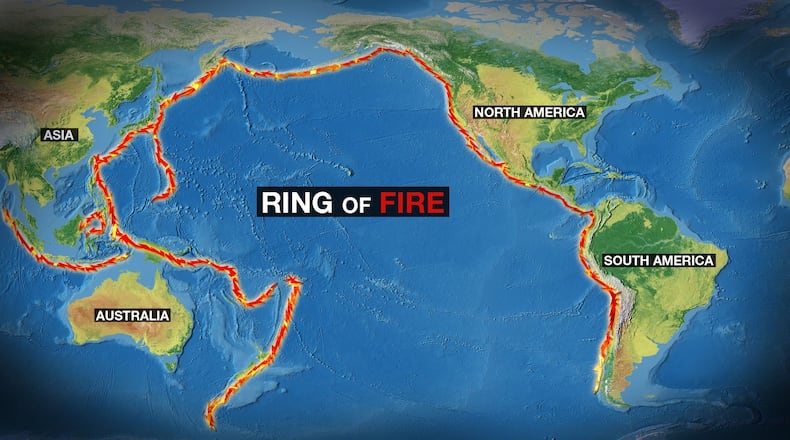Ohio sits on the edge of the New Madrid Seismic Zone, an area that includes Missouri and adjacent states. In 1811 and 1812, four destructive quakes happened here and were felt throughout the eastern United States. Reports show the quakes were strong enough to topple chimneys in Cincinnati. It’s been estimated their magnitudes ranged around 8.0 on the Richter Scale.
The Richter Scale is a measurement of an earthquake’s magnitude (size), ranging from less than 1.0 to 8.0 or higher. The higher the number the stronger the quake. Earthquakes of 2.9 or less are typically not felt by people, but are recorded by equipment. Earthquakes of 8.0 or higher can cause severe destruction and loss of life over large areas.
Most earthquakes recorded across the globe tend to fall in an area that surrounds the Pacific Ocean called the “Ring of Fire.” Also called the Circum-Pacific Belt, the Ring of Fire is where 90 percent of the world’s earthquakes occur. This ring stretches from the west side of South America, up the coastline of North America to Alaska, across the Pacific Ocean to the east side of Asia, down through the Philippines, ending off the east coast Australia.
Earthquakes are caused the sudden slip along a fault line as tectonic plates move. They are always moving, but sometimes get stuck on the edge of a bordering plate. Pressure builds near this point of friction. Eventually the energy is released in the form of an earthquake.
There are three types of earthquakes that can occur, Convergent Boundary, Divergent or a Transform Fault.
- Convergent boundary: One plate is forced over another plate during movement, creating a thrust fault.
- Divergent boundary: Pates are forced apart each other, usually forming a Rift Zone. This kind is common in ocean floors where new floors are created. An example is the Mid Atlantic Ridge.
- Transform fault: Unlike divergent and convergent, the plates here slip by each other. This is also called Strike-Slip.
If you ever find yourself somewhere when an earthquake occurs, the Red Cross says there are a few things you can do to stay safe.
If you’re inside a building:
- Drop, cover and hold on!
- Move as little as possible - most injuries during earthquakes occur because of people moving around, falling and suffering sprains, fractures and head injuries.
- Try to protect your head and torso.
- If you are in bed, stay there, curl up and hold on, and cover your head.
- Stay indoors until the shaking stops and you are sure it is safe to exit.
- If you smell gas, get out of the house and move as far away as possible.
- Before you leave any building, check to make sure that there is no debris from the building that could fall on you.
If you’re outside
- Find a clear spot and drop to the ground. Stay there until the shaking stops.
- Try to get as far away from buildings, power lines, trees, and streetlights as possible.
- If you're in a vehicle, pull over to a clear location and stop. Avoid bridges, overpasses and power lines if possible.
- Stay inside with your seatbelt fastened until the shaking stops.
- After the shaking has stopped, drive carefully, avoiding bridges and ramps that may have been damaged.
- If a power line falls on your vehicle, do not get out. Wait for assistance.
- If you are in a mountainous area or near unstable slopes or cliffs, be alert for falling rocks and other debris as well as landslides.
About the Author
